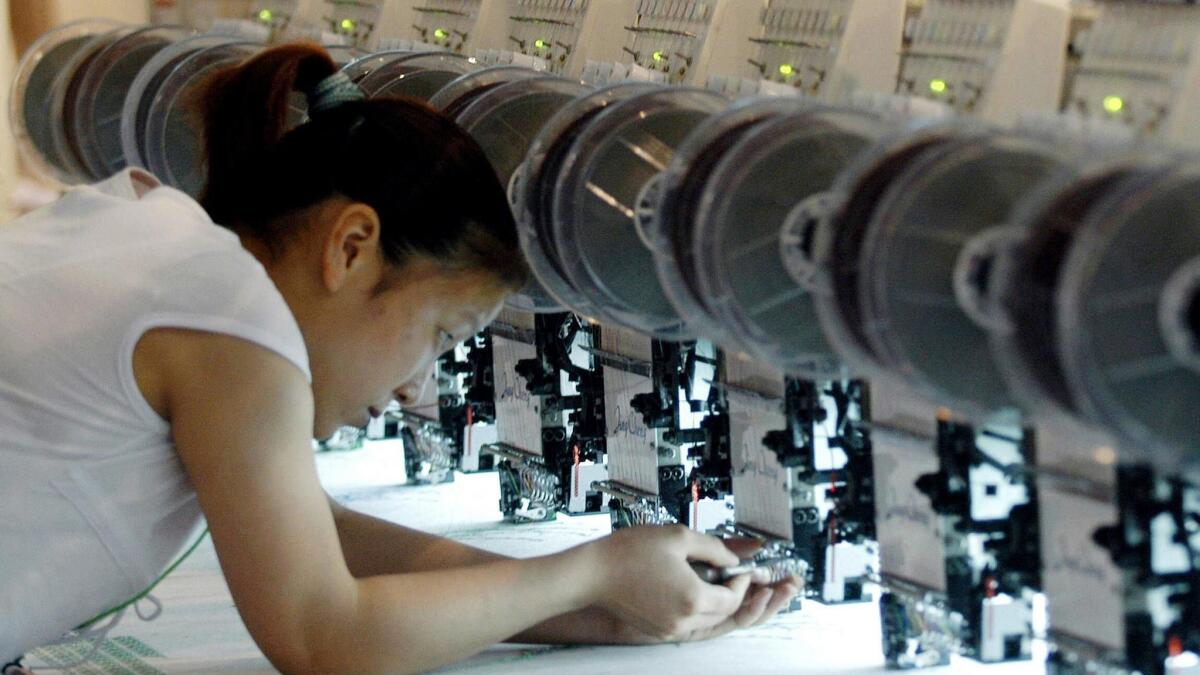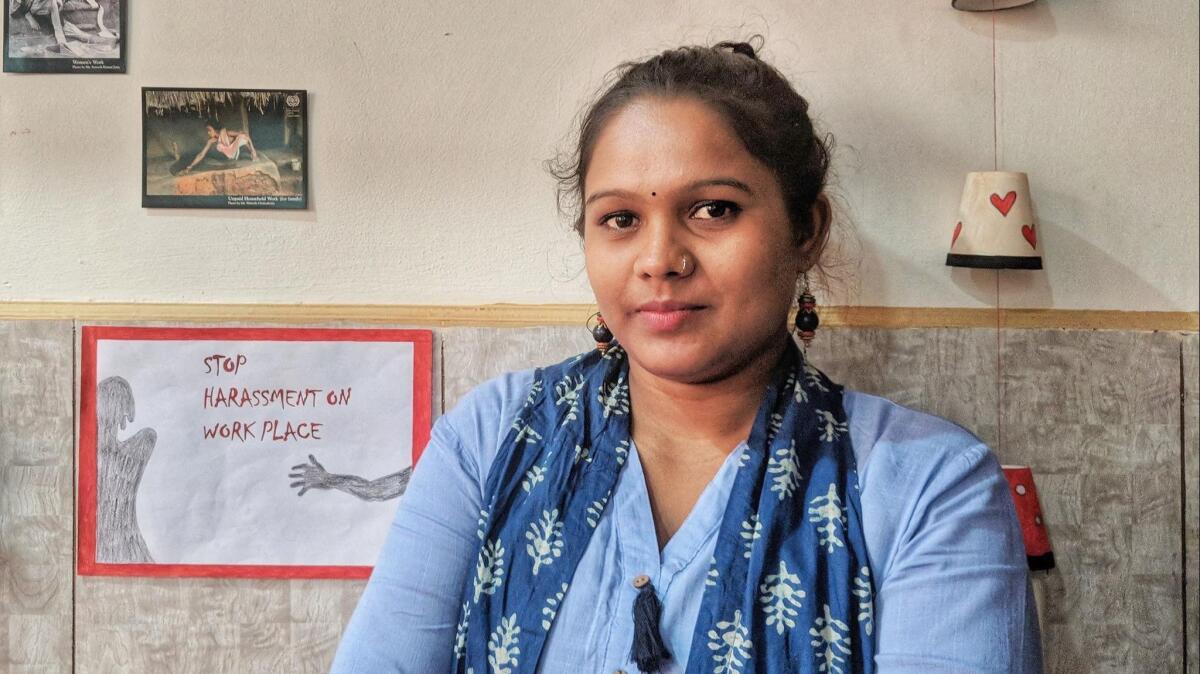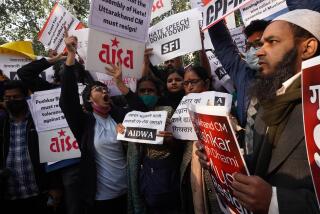Despite #MeToo wave in India, women in low-wage jobs still suffer widespread harassment

- Share via
Reporting from Gurgaon, India — Six months into a stitching job at a big garment factory outside New Delhi, B. Devi says, her supervisor caressed her shoulder. The 36-year-old married mother of four didn’t respond. But she wondered at the time, she now recalls, whether her long cotton kurta top was too revealing.
The next day she wound a scarf more carefully around her head and chest. But a few days later, she says, her supervisor touched her again, more forcefully, and propositioned her.
“Madam,” she says he told her, “if you want to work here, you have to come out with me.”
Devi had heard from other women what that meant — if she provided him with sexual favors, he would ensure her timely payment and easier tasks at the factory in Gurgaon, which supplies merchandise to major American retailers.
She refused, but his advances continued until July, when she snapped at him after he touched her, she says. She was immediately dismissed from work and lost her pay for that month, about $110.
Despite laws aimed at enabling workers to report cases of workplace harassment, Devi did not file a complaint against her boss. She shared her account on condition that her full name and her former employer’s not be published, because she feared it would prevent her from getting another job and because she hadn’t shared details of the case with family members.
Ripples of the #MeToo movement have reached India’s shores as droves of white-collar women speak out against rampant sexual harassment and abuse, primarily in the media and entertainment industries.
Top actors and directors, comedians, authors and high-profile journalists have been accused of unwanted advances and sexual misconduct. The government’s junior minister for external affairs resigned after allegations from more than a dozen women who worked for him during his previous career as a newspaper editor.
But in the low-wage sectors that employ most Indian women who work in the formal economy, sexual harassment remains shrouded in silence.
After agriculture, the garment industry is the second-largest employer in India, supplying to global clothing giants. Women make up approximately 60% of the industry’s workforce, most coming from poor or rural backgrounds that make them more vulnerable to exploitation.
In 2016, Sisters for Change, a British advocacy group, found that 1 in 7 female workers in the Indian industrial hub of Bangalore said they experienced sexual violence in the workplace. Three out of four reported that there was no functioning procedure to file complaints in such cases.
India adopted its first workplace sexual harassment guidelines in 1997 — following the alleged gang rape of an anti-child-marriage activist — and in 2013 issued more stringent guidelines for companies to deal with unwanted physical contact, advances, requests for sexual favors and suggestive remarks reported by employees.
According to the 2013 law, if an allegation is found to be true, the employer can demand an apology to the victim, fire the offender or impose financial or other penalties.
But fear of losing jobs and the stigma of sexual harassment continue to result in many incidents going unreported. According to figures from the Ministry of Women and Child Development, 533 cases were filed under the act as of July.
San Francisco-based Gap Inc. is one of the few major multinational apparel companies to furnish details concerning their global vendors. After the company’s internal assessments found sexual harassment was “particularly acute” at its suppliers in India — which employ more than 100,000 workers — Gap in 2016 began conducting sensitization programs in factories and worked to strengthen their compliance with Indian legal requirements, company spokeswoman Laura Wilkinson said.
But in a report in May, a group of international labor rights organizations documented rampant gender-based violence in Gap supply chains in India, Bangladesh, Sri Lanka, Indonesia and Cambodia, and declared that female workers were “subjected to routinized sexual harassment.” The group found similar problems in Asian factories that supply H&M and Walmart.
Wilkinson said Gap was “deeply troubled” by the allegations and had redoubled its efforts to ensure its vendors train all their employees on legal workplace behavior.
The factory where Devi worked says it supplies retailers including Gap, Macy’s and Ann Taylor. Wilkinson said Gap was not familiar with Devi’s specific case, which Devi did not report.
Ann Taylor’s parent company said in a statement that it took allegations of sexual harassment “very seriously” and conducted regular audits of its suppliers to ensure the factories complied with company regulations and local laws.
Macy’s did not respond to requests for comment.
Devi said that her boss asked her to go out with him at least five times. Once, she said, he called her to his office, held her palm and rubbed it while she shifted on her feet, staring at the floor.
“You have to work according to my demands if you want to keep your job,” she said he told her.
“Sir, I am married with four children,” she replied. “I have to feed them, pay their school fees. I can’t afford to lose this job.”
He leered at her. “Why do you have to be so virtuous if you need the money?” he said.
After she lost her job, Devi decided against complaining to the factory but approached the office of a union representing women workers in Gurgaon in the hope of recovering her dues.

At the union’s tiny office, sitting next to a whiteboard with a list of behavior and speech that constitutes sexual harassment, 25-year-old activist Anita Yadav said most women remained unaware of what qualified as an offense under Indian law.
“We hold regular meetings to encourage them to share stories of harassment and the process of redressal if they want,” Yadav said.
For most Indian women, such behavior isn’t restricted to the factory floor, Yadav said. Rape, molestation, catcalling on streets and domestic violence are deeply entrenched in India’s largely patriarchal society.
“A lot of them have faced such behavior in everyday life, on roads or in their neighborhoods, so they consider it routine,” Yadav said. “The older women are used to it and don’t have much hope. We focus on the younger women so they don’t take it lying down and resist the system.”
Sexual harassment and conservative views about gender roles are among the reasons why more Indian women are dropping out of the workforce, according to an investigation last year by IndiaSpend, a news website. Only about 27% of Indian women hold jobs, lagging far behind not only industrialized nations but also neighbors including Nepal and Bangladesh.
For Devi, waging a legal battle is out of the question because she fears the stigma and being labeled a problem worker in the close-knit industry. She hasn’t even told her husband or teenage children about the harassment, saying only that she was fired over a dispute. She worried that her husband might blame her for inviting the advances.
Her other worry was finding another job.
“If I complain, the word will go around and I will be blacklisted by other factories,” she said.
Devi does not own a smartphone and hadn’t heard of the #MeToo movement making waves on another level of Indian society. When told of it, she nodded in agreement, saying it was a good thing for women to speak out publicly and name their abusers — even if she wasn’t ready to do so herself.
Masih is a special correspondent.
More to Read
Sign up for Essential California
The most important California stories and recommendations in your inbox every morning.
You may occasionally receive promotional content from the Los Angeles Times.









